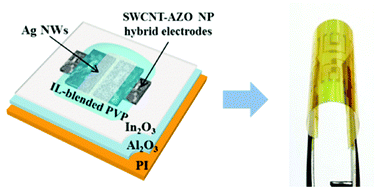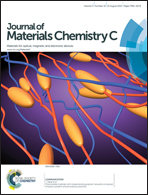Effective work function modulation of SWCNT–AZO NP hybrid electrodes in fully solution-processed flexible metal-oxide thin film transistors†
Abstract
Work function modulation of electrode materials is a crucial factor for achieving superior performance in transparent and flexible device applications. In this work, aluminum-doped zinc-oxide nanoparticles (AZO NPs) with a low work function were introduced in single-walled carbon nanotube (SWCNT) transparent electrodes to achieve an Ohmic contact with an indium-oxide (In2O3) active layer. These SWCNT–AZO NP hybrid electrodes exhibited a low contact resistance with the solution-processed In2O3 active layer, due to the low work function of the AZO NPs physisorbed on the SWCNTs. The 50 nm thick SWCNT–AZO NP hybrid films showed a considerably low electrical resistance of 214.5 Ω sq−1, an optical transmittance of 82.1% and a work function of 4.57 eV. By using these materials as the source and drain electrodes, fully solution-processed In2O3 thin film transistors (TFTs) were fabricated, and they showed excellent device performance. Furthermore, the fully solution-processed flexible In2O3 TFTs with these SWCNT–AZO NP hybrid electrodes exhibited only a 2.02% decrease in the field effect mobility after 1000 cycles of repeated bending stress at a radius of curvature of 3 mm.


 Please wait while we load your content...
Please wait while we load your content...